Nature Notes
by Bob Thomas
November and December are the months of amnesty in south Louisiana. To be clear, my dislike for the most aggressive alien invader of our woodlands, Chinese tallow (Triadica sebifera, formerly called Sapium sebiferum), sometimes called chicken (they allegedly love tallow seeds) or popcorn (the white seeds look like popcorn) tree, transforms into a period of appreciation for the aesthetic beauty shown by the species’ broad spectrum of colors in its fall foliage.
Chinese tallow is so named because it was introduced from China to the United States in Charleston, South Carolina, in the late eighteenth century by the French botanist Francois Michaux, although Ben Franklin frequently gets "credit," or is it blame? The original intent of its introduction was to develop a soap industry based on the wax coating of the white seeds.
In early spring, tallows produce catkins, or aments, that contain both male and female flowers. They smell very sweet, and are popular with bees, producing a very tasty honey.
Tallows are extremely genetically variable. Have you noticed that some tallow trees lose their leaves while others retain them? Some turn red, maroon and yellow while others remain green? Some have ripe seeds while others don't? This extreme variability allows propagators to select trees with certain characteristics, such as amount of wax on the seeds, that are deemed desirable and, by artificially crossing them or collecting and planting their seeds, expand the presence of those characteristics in the orchard.
Even though seed production once reached 10,000 pounds per acre, the tallow orchard venture failed because harvest by hand was not cost effective. The abandoned orchards spread quickly and the tallow is now one of the most abundant trees along the Gulf and U.S. south Atlantic coasts. Birds eating and eliminating their seeds facilitated the rapid dispersal. Additionally, people frequently chip them and use the chips to cover walkways and trails, a big mistake since this is a human way to introduce seeds to new areas. Their ultimate success is due to the same features that unfortunately endear tallows to the hearts of new homeowners in the New Orleans area, especially their tolerance of poor soils and rapid growth. Yes, Chinese tallows are sold in virtually all local nurseries, and people buy them!
The trees will grow virtually anywhere and may reach 40 feet tall within 10 years. They are, however, quite messy, constantly dropping limbs, and short-lived (about 40 years). Tallows are herba non grata in most natural places since they grow much more rapidly than our native trees and thus out-compete and rapidly replace them.
November-to-December, as mentioned, is a period of brief truce between tallows and many naturalists due to the trees’ lovely yellow, red, and maroon leaves mixed with the brilliant white seeds which resemble popcorn and provide low preference food for birds. Some call it the Cajun New England.
Tallows have also been planted to stabilize banks in rapidly eroding wetlands. They proved to be hardy in these environs and their roots hold the soil together.
Nevertheless, the leaves soon fall and the battle wages on. Tallows are very difficult to eliminate due to rapid growth of shoots from stumps. Once established in a woodland, they are virtually impossible to remove. As a wise old Cajun once said, "You don't kill tallows, you just make them mad!"
Tallows need to go!
Also published in Delta Journal, The Times Picayune, November 4, 2007 and October 25, 1989.
Also published in Nature Profile, The Times Picayune, July 18, 1984.
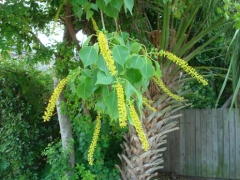
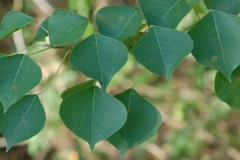
Spring leaves and catkins, or aments, of Green fall leaves on a tallow at the
Chinese tallow, Triadica sebifera. The Louisiana Nature Center.
catkins contain both male and female Photo by Bob Thomas.
flowers.
Photo by Bob Thomas.
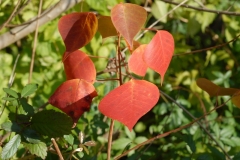
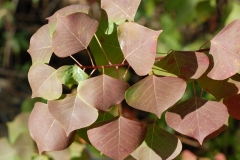
Red fall leaves on a tallow at the Fall tallow leaves may be maroon, as are
Louisiana Nature Center. these at the Lousiana Nature Center.
Photo by Bob Thomas. Photo by Bob Thomas.
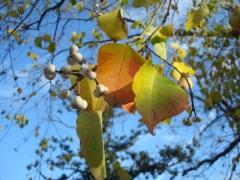
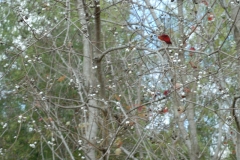
Leaves showing green, yellow and red This tallow, growing in Madisonville, LA, is
share twigs with seeds on a tallow growinig covered with white seeds. All of its leaves
in Uptown New Orleans in late fall. have already fallen.
Photo by Bob Thomas. Photo by Bob Thomas.
